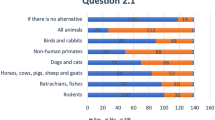Abstract
It is argued that cultural attitudes of a speciesist nature are background to the current practice of animal use in teaching medical students and residents. The scope of this activity is estimated, and educational theory is enlisted to suggest that many assumptions about the effectiveness of the practice are not valid. An assessment of one course used for ob-gyn training is presented. Since it is clear that animal suffering should be avoided when possible, the case is made that alternatives to animals may be used to replace animal use in much of current medical education. Medical educators should routinely question and offer adequate justification for any use of animals in medical education.
Similar content being viewed by others
References
Midgley M.Animals and Why They Matter. Athens, Georgia: University of Georgia Press, 1983.
Tamir P, Hamo A. Attitudes of secondary school students in Israel toward the use of living organisms in the study of biology.International Journal for the Study of Animal Problems 1980;1:299–311.
Rollins BE.Animal Rights and Human Morality. Buffalo, NY: Prometheus Books, 1981.
Fishlock DJ. Anti-vivisectionist students are refusing to harm animals in classes, laboratories.The Chronicle of Higher Education 1987 (July 15): 33–4.
Congress of the United States Office of Technology Assessment.Animal Use in Education and the Alternatives to Animal Use in Research, Testing, and Education. Washington, D.C.: U.S. Government Printing Office, 1986.
Woods Jr, Ansbacher R, Castro RJ, Marshall W, Trabal JF. Animal surgery: an adjunct training in obstetrics and gynecology.Obstet Gynecol 1980;56:373–6.
Rodd R. Pacifism and absolute rights for animals: a comparison of difficulties.Journal of Applied Philosophy 1985;2:53–61.
Becker LC. The priority of human interests. In: Miller HB, Williams WH, eds.Ethics and Animals. Clifton, NJ: Humana Press, 1983:229.
Fox MW.Returning to Eden. New York: Viking Press, 1980.
Rowan AN.Of Mice, Models, and Men: A Critical Evaluation of Animal Research. Albany, NY: State University of New York Press, 1984.
Author information
Authors and Affiliations
Rights and permissions
About this article
Cite this article
English, D.C. Using animals for the training of physicians and surgeons. Theor Med Bioeth 10, 43–52 (1989). https://doi.org/10.1007/BF00625758
Issue Date:
DOI: https://doi.org/10.1007/BF00625758




